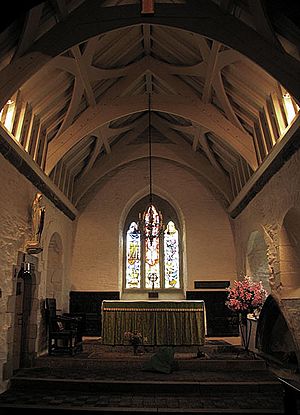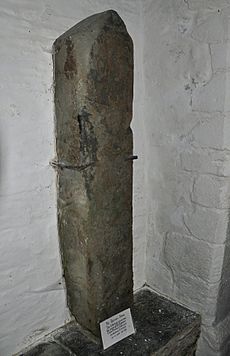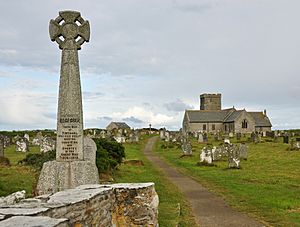St Materiana's Church, Tintagel facts for kids
Quick facts for kids St Materiana's Church, Tintagel |
|
|---|---|
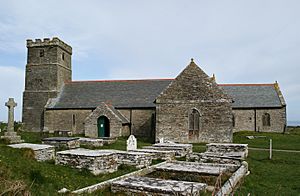
Tintagel Parish Church
|
|
| 50°39′47″N 4°45′35″W / 50.6630°N 4.7597°W | |
| Denomination | Church of England |
| Churchmanship | High Church |
| Website | www.achurchnearyou.com |
| History | |
| Dedication | St Materiana |
| Administration | |
| Parish | Tintagel |
| Deanery | Stratton |
| Archdeaconry | Bodmin |
| Diocese | Truro |
| Province | Canterbury |
St Materiana's Church is a beautiful old church located in Tintagel, a village in Cornwall, England. It's a Church of England church, meaning it's part of the main Christian church in England. You can find it standing proudly on the cliffs between the village of Trevena and the famous Tintagel Castle. This church is very important, so it's listed as a Grade I historic building.
People believe the very first church here was built a long, long time ago, around the 500s! It was likely a "daughter church" of another church called Minster. St Materiana is a special saint, and these are the only churches dedicated to her. Some think she was Madryn, a princess from Wales. Others suggest she might have been Saint Marcellina, the sister of Saint Ambrose.
Contents
The Church Building Today
The church building you see today might have been built in the late 1000s or early 1100s. An art expert named Nikolaus Pevsner thought its Norman design also had some older Saxon features. The church tower could be from the 1200s or 1400s.
Changes Over Time
The biggest change to the church happened in 1870. This was a "Victorian restoration" led by Piers St Aubyn, which included adding a new roof. Later, the pipe organ was moved twice. Many new stained glass windows were also added. These windows show different saints, like St Materiana, St George, and St Piran.
You can also see three modern copies of famous old paintings inside. There's even a Roman milestone from the time of Emperor Licinius, who died in 324 AD. The church tower has six bells that ring out. The oldest bell is from 1735, and the newest is from 1945. As of 2016, an electric organ is used instead of the old pipe organ.
Both the north and south entrances to the church are from the Norman period. The north entrance is simpler and might be older. The north porch was probably built in the 1300s. The south porch was rebuilt later, but it started in the 1200s.
The font, which is a large basin for baptisms, is also Norman. It's carved from a local stone called elvan. Each of its four sides has carvings of snakes, and each corner has a carved head. Three of the windows in this part of the church are Norman too. The largest window shows St George.
The walls in the central part of the church were meant to hold a tall tower. However, this tower was either never finished or was taken down because it wasn't safe. You can also see a stone coffin lid from the late 1200s, which might be for a priest.
The Chancel Area
The rood screen, a decorative screen that once separated the nave from the chancel, is from the 1400s. It used to have a canopy, but that was removed, probably during the Reformation. In the south wall, there's a special recess called the Founder's Tomb, likely from the 1300s.
The east window is newer and remembers Father Canner, who was the vicar from 1950 to 1976. On the north wall, there's a statue of St Materiana, the church's patron saint. This statue remembers Parson Chapman, who was the vicar from 1894 to 1916.
The chapel on the north side of the chancel is the old Lady Chapel. It's hard to say exactly when it was built, but it must be newer than the chancel. It still has a medieval stone altar. The recess on the north side used to be where the organ was, but now it's used as a vestry, a room where priests prepare.
Exploring the Transepts
The altar in the north transept is modern. It was first dedicated to All Saints but is now usually called St Symphorian's altar. This is because of the window behind it. The north window remembers John Douglas Cook, who was an editor of a newspaper called the Saturday Review. He is buried in the churchyard nearby.
The south transept is a bit longer than the north one. It might have been made longer to fit a tomb. A stone bench runs along some of the walls. This was from a time when churches didn't have other seats.
A Roman stone with writing on it is in this transept. It's from the early 300s AD and has the name of Emperor Licinius, who died in 324 AD. This stone was found in 1889, built into the churchyard's western gate. There's also a memorial brass for Joan, who died around the 1430s. She was the mother of John Kelly, who was a vicar here from 1407 to 1427.
The Church Tower
The tower at the west end of the church was built in the 1300s. Battlements, which are the notched tops of castle walls, were added in the 1400s. The five older bells in the tower are from 1735, 1785, 1828, and two from 1868. A sixth bell was added in 1945. The largest bell, called the tenor bell, weighs about 770 pounds! The west window has modern stained glass showing coats of arms linked to the church's history.
The Churchyard
The churchyard here is very large for Cornwall. It has been made bigger three times. The older part is round, and newer areas were added in the early 1800s and mid-1900s. The north-east part used to be farmland.
The churchyard cross and the war memorial are both modern and made of granite. All the gravestones from before the Victorian era are made of local slate. The oldest ones are from between 1690 and 1710. People did some digging here in 1990 and 1991, to the north-west of the church.
Interesting Memorials
Some of the most interesting memorials include the tomb of John Douglas Cook, the first editor of the Saturday Review, who died in 1868. His tomb is north-west of the church. There's also a wooden cross over the grave of Domenico Catanese, who died in 1893.
On December 20, 1893, a ship called the Iota crashed against Lye Rock. The crew managed to get onto the rock, and everyone but a 14-year-old boy was saved. His grave is marked by the wooden cross.
A book cover for J. L. Carr's A Month in the Country actually shows Tintagel Parish Church, even though the story takes place in Yorkshire! Some old graves found outside the churchyard wall in 1956, during farming, might have inspired this. Experts believe these graves are from between 500 and 1000 AD.
Church Records
The church keeps records of important events. The burial records start in 1546, baptism records in 1569, and marriage records in 1588. For many years, up to 1668, one person copied all the older records into a new book.
Past Vicars
The first vicar recorded was Gervase de Truueru in 1259. The person who served the longest was Gerance Davye, from 1581 to 1629. The second longest-serving was Richard Byrn Kinsman, from 1851 to 1894. Since 1534, the church's patrons, who help choose the vicar, have been the Dean and Canons of Windsor. Before that, in the 1200s and 1300s, the French abbey at Fontevrault was the patron.
- Gervase de Truueru 1259-1276
- Roger de Hemptone 1276-c. 1306
- Martyn Skynard c. 1306-1321
- Hamund de Alternon 1321-1339
- Peter de Sulihulle 1339-1349
- Ralph Trevyseke 1349-1362
- Reginald Revel 1362-c. 1380
- Stephen Goof c. 1380-1400
- John Kelly 1407-1427 (afterwards dean of Crantock)
- Gerance Davye 1581-1629
- Richard Byrn Kinsman 1851-1894 (also honorary constable of the castle and prebendary of Exeter)
- Arthur Grieg Chapman 1894-1917
- Arthur Cuthbert Canner 1950-1976 (also curate 1941 - 1945)
- Ivan Henry Gregory S.S.C. 1977-1994
- David John Rake (priest in charge) 1998-2008
- John Barfoot (priest in charge) 2008–2013
- Michael Parsons / Robert S. Thewsey Rector 2013-2017
- Heather Jane Aston (priest in charge) 2017-present
Church Group and Location
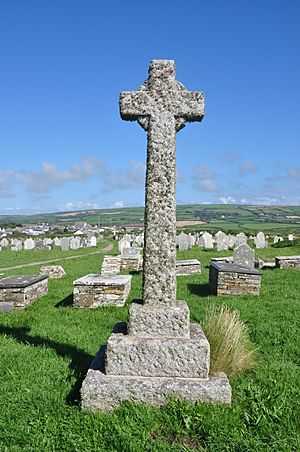
St Materiana's Church is part of a group of parishes called the Boscastle and Tintagel group. This group includes several other churches in the area, such as:
- St Symphorian's Church, Forrabury
- St Merteriana's Church, Minster
- St Michael and All Angels' Church, Lesnewth
- St Denis' Church, Otterham
- St Julitta's Church, St Juliot
- The Holy Family Church, Treknow
- St Piran's Church, Trethevy
- St Petroc's Church, Trevalga
The parish used to be in a deanery called Trigg Minor. Now it is part of the Stratton deanery.
See also
 In Spanish: Iglesia de Santa Materiana (Tintagel) para niños
In Spanish: Iglesia de Santa Materiana (Tintagel) para niños




